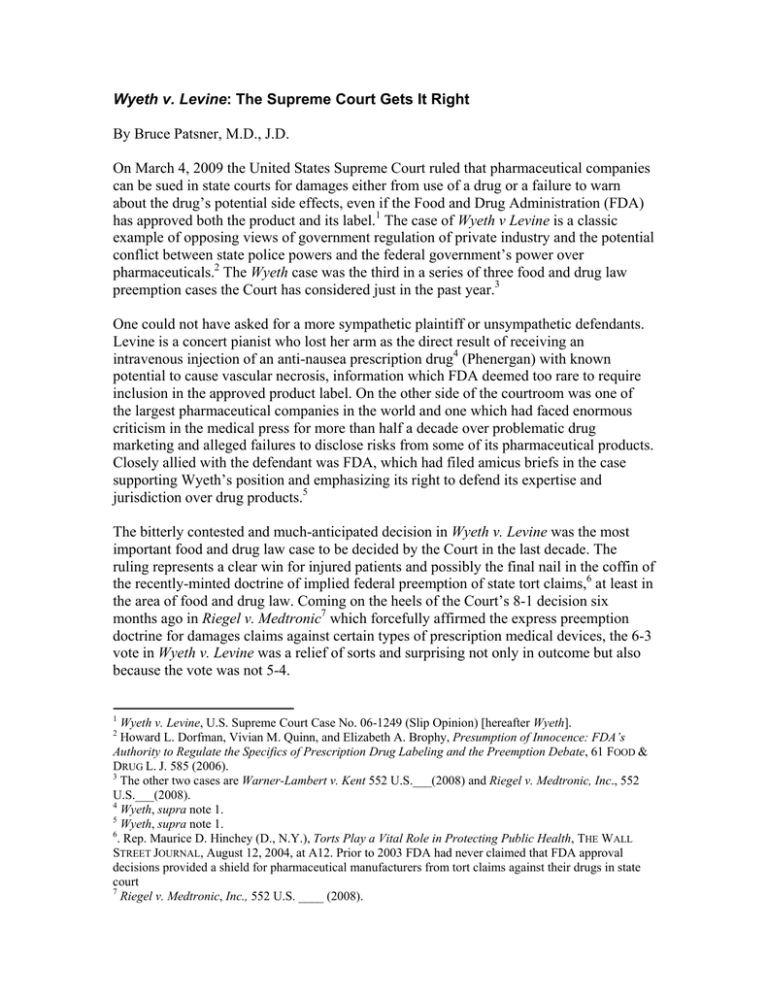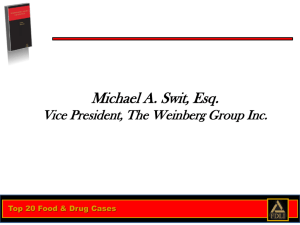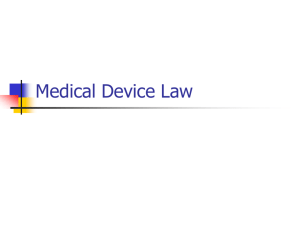Wyeth v. Levine By Bruce Patsner, M.D., J.D.
advertisement

Wyeth v. Levine: The Supreme Court Gets It Right By Bruce Patsner, M.D., J.D. On March 4, 2009 the United States Supreme Court ruled that pharmaceutical companies can be sued in state courts for damages either from use of a drug or a failure to warn about the drug’s potential side effects, even if the Food and Drug Administration (FDA) has approved both the product and its label.1 The case of Wyeth v Levine is a classic example of opposing views of government regulation of private industry and the potential conflict between state police powers and the federal government’s power over pharmaceuticals.2 The Wyeth case was the third in a series of three food and drug law preemption cases the Court has considered just in the past year.3 One could not have asked for a more sympathetic plaintiff or unsympathetic defendants. Levine is a concert pianist who lost her arm as the direct result of receiving an intravenous injection of an anti-nausea prescription drug4 (Phenergan) with known potential to cause vascular necrosis, information which FDA deemed too rare to require inclusion in the approved product label. On the other side of the courtroom was one of the largest pharmaceutical companies in the world and one which had faced enormous criticism in the medical press for more than half a decade over problematic drug marketing and alleged failures to disclose risks from some of its pharmaceutical products. Closely allied with the defendant was FDA, which had filed amicus briefs in the case supporting Wyeth’s position and emphasizing its right to defend its expertise and jurisdiction over drug products.5 The bitterly contested and much-anticipated decision in Wyeth v. Levine was the most important food and drug law case to be decided by the Court in the last decade. The ruling represents a clear win for injured patients and possibly the final nail in the coffin of the recently-minted doctrine of implied federal preemption of state tort claims,6 at least in the area of food and drug law. Coming on the heels of the Court’s 8-1 decision six months ago in Riegel v. Medtronic7 which forcefully affirmed the express preemption doctrine for damages claims against certain types of prescription medical devices, the 6-3 vote in Wyeth v. Levine was a relief of sorts and surprising not only in outcome but also because the vote was not 5-4. 1 Wyeth v. Levine, U.S. Supreme Court Case No. 06-1249 (Slip Opinion) [hereafter Wyeth]. Howard L. Dorfman, Vivian M. Quinn, and Elizabeth A. Brophy, Presumption of Innocence: FDA’s Authority to Regulate the Specifics of Prescription Drug Labeling and the Preemption Debate, 61 FOOD & DRUG L. J. 585 (2006). 3 The other two cases are Warner-Lambert v. Kent 552 U.S.___(2008) and Riegel v. Medtronic, Inc., 552 U.S.___(2008). 4 Wyeth, supra note 1. 5 Wyeth, supra note 1. 6 . Rep. Maurice D. Hinchey (D., N.Y.), Torts Play a Vital Role in Protecting Public Health, THE WALL STREET JOURNAL, August 12, 2004, at A12. Prior to 2003 FDA had never claimed that FDA approval decisions provided a shield for pharmaceutical manufacturers from tort claims against their drugs in state court 7 Riegel v. Medtronic, Inc., 552 U.S. ____ (2008). 2 At the very least, the majority of the Court recognized that the statutory basis for claiming federal preemption protection for damages claims in state court for drugs and medical devices differs enormously.8 The 1976 Medical Device Amendments (MDA) to the 1938 Federal Food, Drug and Cosmetic Act (FDCA)9 contains an express preemption clause which specifically exempts manufacturers from tort liability in state court for damages from FDA-approved medical devices or adding additional “requirements” to the existing federal medical device safety and efficacy marketing evaluation.10 There is no comparable preemption language relating to pharmaceuticals in the 1938 FDCA or any amendment to the FDCA since its inception.11 The language of the preemption clause in the MDA did not distinguish among the three different safety classes of medical devices it created,12 nor did it limit preemption protection for medical devices based on the route (i.e. via 510k clearance or PreMarketing Approval [PMA] ) the device reached U.S. markets.13 Even so, in the Medtronic v. Lohr14 decision the Supreme Court narrowed the scope of medical device preemption protection to only those prescription medical devices which are approved through the lengthier and more complicated PMA route rather than the more commonly use 510k clearance mechanism.15 The Arguments In holding that FDA approval and the FDA label did not protect pharmaceutical manufacturers against tort litigation in state court, the Supreme Court majority rejected arguments from both manufacturers and FDA itself. Wyeth had argued, in effect, that the information contained in an FDA-approved product label is both the floor and the ceiling for potential tort claims and that the label cannot be unilaterally changed without FDA approval.16 Neither of these legal arguments was viewed favorably by the Court. The contents of the label invariably represent a negotiation between FDA and industry;17 the sponsor owns the label (i.e. it is its intellectual property), and the label is always the last part of the new drug application (NDA) to be completed.18 Moreover, FDA decisionmaking on what to include in a prescription drug label is fraught with potential errors and omissions, as the case at hand demonstrates. The plaintiffs argued that Wyeth had failed to provide a strong and clear warning to consumers (and physicians) about the risks of rapid intravenous injection of the drug, and both the Vermont jury and the U.S. Supreme Court accepted this argument. Writing for 8 MEDICAL DEVICE AMENDMENTS OF 1976, 21 U.S.C. § 360(K)(A) [Hereafter MDA]. FEDERAL FOOD, DRUG AND COSMETIC ACT, 21 U.S.C. § 396 (1938) [Hereafter FDCA]. 10 MDA, supra note 10. 11 FDCA, supra note 11. 12 MDA, supra note 10 13 Id. 14 Medtronic, Inc. v. Lohr, 518 U.S. 470 (1996). 15 Id. 16 Wyeth, supra note 1. 17 Id. 18 MARK MATHIEU, NEW DRUG DEVELOPMENT: A REGULATORY OVERVIEW (6TH ED. 2002). 9 the majority in the Wyeth decision, Justice John Paul Stevens pointed out that Wyeth always had the option of unilaterally strengthening its warning.19 Justice Stevens did leave open the possibility that there could be instances where tort lawsuits against drug manufacturers would not be allowed in state courts as they would be preempted. Justice Stevens noted that in those cases where the manufacturer of a drug had specifically requested, and FDA had specifically rejected, a drug label with a stronger warning,20 tort lawsuits against the manufacturer in state courts would be preempted. The Court’s decision in Wyeth also seemed to accept the fact that the information contained in the label is not set in stone and to embrace the notion that the label is a generative document which is expected to evolve over time as more information about a marketed drug becomes available. Given the mathematical certainty that uncommon adverse events will not be detected in drug approval trials because the number of participants is much smaller than the number of individuals who will be exposed to the drug once it is approved, it is impossible for a drug label to include all of the important warning information both physicians and patients need.21 Companies are always free to add more safety warning information to their drug label; up until now the fighting with FDA always occurs over the desire of sponsor’s to limit safety information in the label. An intentional decision by FDA not to include known serious adverse event information requested by a manufacturer in a label would not only be antithetical to FDA’s public health mission,22 it would represent a serious error on the agency’s part and, on examination, be just one more reason why the Court’s decision was correct. The Court also appropriately rejected FDA’s argument that manufacturers deserve preemption protection based on FDA approval alone,23 pointing out that this contention was both an about-face of FDA’s previously stated position on this issue24 and was clearly inconsistent with Congressional intent.25 Future Changes to Labeling Requirements and Preemption Protection? The repercussions of the Wyeth and Riegel decisions will likely echo in the hallways of both FDA and Congress for some time. Justice Stevens’ comment on possible routes for manufacturers of pharmaceuticals to obtain preemption protection would appear to shift the way manufacturers negotiate with industry over the contents of the drug label and to incentivize sponsors to push for the inclusion of the maximum amount of adverse event information to be included in the drug label, particularly for rare events. Such a change 19 Wyeth, supra note 1. Id. 21 Louis Lasagna, Discovering adverse drug reactions, 249 JAMA 2224 (1983). 22 UNITED STATES FOOD AND DRUG ADMINISTRATION, FDA MISSION STATEMENT, available at www.fda.gov (last accessed March 8, 2009), “The FDA is responsible for protecting the public health by assuring the safety, efficacy, and security of human and veterinary drugs, biological products, medical devices, our nation’s food supply, cosmetics, and products that emit radiation.” 23 Scott Gottlieb: FDA: Rx Labeling Trumps State Liability Laws, available at: http://www.fdaweb.com/start.php?sa=v&aid=D5101706&cate=&stid=%241%245R5.oh% (last accessed January 19, 2006). 24 Robert Pear, Bush tries to block consumer drug suits, White House says injury claims undermine FDA, N.Y. TIMES, July 25, 2004 at A1. 25 Wyeth Opinion, supra note 1. 20 would also shift the onus of responsibility for excluding such information from the sponsor to FDA. Recent changes to FDA drug labeling rules26 which had been made to favor the notion of FDA preemption protection for drug manufacturers will likely either be revised again or rendered irrelevant as sponsors now push for more, not less, information to be included in the approved drug label. The larger question is whether preemption protection for manufacturers of medical products other than vaccines will survive the change from Republican to Democratic control of the White House and Congress. Efforts are already underway27 to amend the 1938 Federal Food, Drug and Cosmetic Act to eliminate the express preemption protection for medical device manufacturers and allow tort litigation against the manufacturers of implantable medical devices such as cardiac defibrillators, pacemakers, and coronary-artery stents to proceed in state courts. Even if this comes to pass this effort may not have the uniform result Congress desired: individual states always have the option of enacting laws which would allow FDA approval of a prescription drug or overthe-counter drug label to be a bar to litigation in state court for failure to warn claims against the manufacturer. Health Law Perspectives (March 2009), available at: http://www.law.uh.edu/healthlaw/perspectives/homepage.asp 26 Gottlieb, supra note 23. The Associated Press, Bill Would Restore Right to Sue Over Medical Devices, March 6, 2009, available at http://www.nytimes.com/2009/03/06/business/06device.html?_r=1&ref=health&pagewantd (last accessed March 6, 2009). 27






